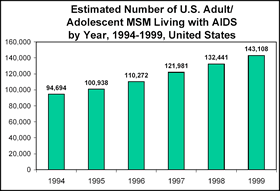|
|
|
|
|
|
||
|
Divisions of HIV/AIDS Prevention |
|||||||
In the United States, HIV-related illness and death historically have had a tremendous
Overall, the number of MSM of all races and ethnicities who are living with AIDS has increased steadily, partly as a result of the 1993 expanded AIDS case definition and, more recently, of improved survival. (See chart at right.)
Continuing Risk Among Young MSM Abundant evidence shows a need to sustain prevention efforts for each generation of young gay and bisexual men. We cannot assume that the positive attitudinal and behavioral change seen among older men also applies to younger men. Recent data on HIV prevalence and risk behaviors suggest that young gay and bisexual men continue to place themselves at considerable risk for HIV infection and other sexually transmitted diseases (STDs).
These data highlight the need to design more effective prevention efforts for gay and bisexual men of color. The involvement of community and opinion leaders in prevention efforts will be critical for overcoming cultural barriers to prevention, including homophobia. For example, there remains a tremendous stigma to acknowledging gay and bisexual activity in African American and Hispanic communities.
Need to Combat Other STDs Studies among MSM who are treated in STD clinics have shown consistently high percentages of HIV infection, ranging from nearly 4% in Seattle to a high of almost 36% in Atlanta. (See CDC’s National HIV Prevalence Surveys, 1997 Summary, Table 1.) Some studies have shown that the likelihood of both acquiring and spreading HIV is 2-5 times greater in people with STDs, and that aggressively treating STDs in a community may help to reduce the rate of new HIV infections. Along with prompt attention to and treatment of STDs, efforts to reduce the behaviors that spread STDs are critical.
Prevention Services Must Reach Both Uninfected and Infected Research has shown that high-risk behavior is continuing in some populations of MSM, including those who are infected with HIV. Because HIV-infected gay and bisexual men are living longer and healthier lives, greater efforts must be made to reach them with behavioral interventions that can help them protect their own health and prevent transmission to others.
For information about national HIV prevention activities, see the following CDC fact sheets:
For more information...
CDC National AIDS Hotline:
CDC National Prevention Information Network:
Internet Resources:
Centers for Disease Control & Prevention National Center for HIV, STD, and TB Prevention Divisions of HIV/AIDS Prevention Contact Us |


 impact on men who have sex with men (MSM). Even though the toll of the epidemic
among injection drug users (IDUs) and heterosexuals has increased during the last
decade, MSM continue to account for the largest number of people reported with
AIDS each year. In 2000 alone, 13,562 AIDS cases were reported among MSM,
compared with 8,531 among
IDUs and 6,530 among men
and women who acquired HIV
heterosexually.
impact on men who have sex with men (MSM). Even though the toll of the epidemic
among injection drug users (IDUs) and heterosexuals has increased during the last
decade, MSM continue to account for the largest number of people reported with
AIDS each year. In 2000 alone, 13,562 AIDS cases were reported among MSM,
compared with 8,531 among
IDUs and 6,530 among men
and women who acquired HIV
heterosexually.